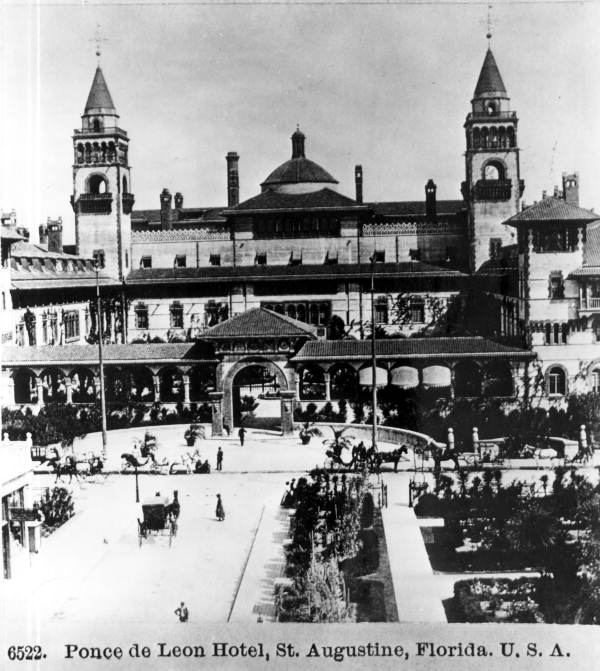St. Augustine, Florida
 In Alonzo Church's account of a speech given by John W. Newman before departing Fort Myers at the start of Expedition, Newman refers to "... the money spent on hotels in the city of St. Augustine to gratify the luxurious tastes of our millionaires." Known today as the "Oldest City" St. Augustine is the oldest continuously occupied European settlement in the continental U.S. It was founded in 1565 by Spanish admiral Pedro Menéndez de Avilés. Oil tycoon Henry Flagler came to St. Augustine in the 1880s determined to build a winter resort for wealthy northerners. By 1891 he had constructed or renovated several opulent hotels, including the Hotel Ponce de Leon, the Alcazar, and the Casa Monica (renamed Cordova), and his dream was realized as St. Augustine became a major tourist destination. Flagler also bought local railway companies and began to develop the Florida East Coast Railway. St. Augustine served as the headquarters for Flagler's Florida East Coast Railway and Model Land Company. James E. Ingraham served as an officer in both companies, as well as several smaller Flagler companies. From 1915 until 1920 Ingraham was mayor of St. Augustine. As Flagler and Ingraham developed the states Atlantic coast by extending the railroad and building a series of hotels along the road, St. Augustine continued to serve as the base of their operations. The population was 4,742 according to the 1890 Census.
In Alonzo Church's account of a speech given by John W. Newman before departing Fort Myers at the start of Expedition, Newman refers to "... the money spent on hotels in the city of St. Augustine to gratify the luxurious tastes of our millionaires." Known today as the "Oldest City" St. Augustine is the oldest continuously occupied European settlement in the continental U.S. It was founded in 1565 by Spanish admiral Pedro Menéndez de Avilés. Oil tycoon Henry Flagler came to St. Augustine in the 1880s determined to build a winter resort for wealthy northerners. By 1891 he had constructed or renovated several opulent hotels, including the Hotel Ponce de Leon, the Alcazar, and the Casa Monica (renamed Cordova), and his dream was realized as St. Augustine became a major tourist destination. Flagler also bought local railway companies and began to develop the Florida East Coast Railway. St. Augustine served as the headquarters for Flagler's Florida East Coast Railway and Model Land Company. James E. Ingraham served as an officer in both companies, as well as several smaller Flagler companies. From 1915 until 1920 Ingraham was mayor of St. Augustine. As Flagler and Ingraham developed the states Atlantic coast by extending the railroad and building a series of hotels along the road, St. Augustine continued to serve as the base of their operations. The population was 4,742 according to the 1890 Census.
Credits:
Sources:
References in the Texts:
Links below open in a new browser window.
For other topics referenced in the Expedition texts, please refer to the Index to Subjects and Names.
1892 Everglades Exploration Expedition : Three Digital Texts, 2015
 In Alonzo Church's account of a speech given by John W. Newman before departing Fort Myers at the start of Expedition, Newman refers to "... the money spent on hotels in the city of St. Augustine to gratify the luxurious tastes of our millionaires." Known today as the "Oldest City" St. Augustine is the oldest continuously occupied European settlement in the continental U.S. It was founded in 1565 by Spanish admiral Pedro Menéndez de Avilés. Oil tycoon Henry Flagler came to St. Augustine in the 1880s determined to build a winter resort for wealthy northerners. By 1891 he had constructed or renovated several opulent hotels, including the Hotel Ponce de Leon, the Alcazar, and the Casa Monica (renamed Cordova), and his dream was realized as St. Augustine became a major tourist destination. Flagler also bought local railway companies and began to develop the Florida East Coast Railway. St. Augustine served as the headquarters for Flagler's Florida East Coast Railway and Model Land Company. James E. Ingraham served as an officer in both companies, as well as several smaller Flagler companies. From 1915 until 1920 Ingraham was mayor of St. Augustine. As Flagler and Ingraham developed the states Atlantic coast by extending the railroad and building a series of hotels along the road, St. Augustine continued to serve as the base of their operations. The population was 4,742 according to the 1890 Census.
In Alonzo Church's account of a speech given by John W. Newman before departing Fort Myers at the start of Expedition, Newman refers to "... the money spent on hotels in the city of St. Augustine to gratify the luxurious tastes of our millionaires." Known today as the "Oldest City" St. Augustine is the oldest continuously occupied European settlement in the continental U.S. It was founded in 1565 by Spanish admiral Pedro Menéndez de Avilés. Oil tycoon Henry Flagler came to St. Augustine in the 1880s determined to build a winter resort for wealthy northerners. By 1891 he had constructed or renovated several opulent hotels, including the Hotel Ponce de Leon, the Alcazar, and the Casa Monica (renamed Cordova), and his dream was realized as St. Augustine became a major tourist destination. Flagler also bought local railway companies and began to develop the Florida East Coast Railway. St. Augustine served as the headquarters for Flagler's Florida East Coast Railway and Model Land Company. James E. Ingraham served as an officer in both companies, as well as several smaller Flagler companies. From 1915 until 1920 Ingraham was mayor of St. Augustine. As Flagler and Ingraham developed the states Atlantic coast by extending the railroad and building a series of hotels along the road, St. Augustine continued to serve as the base of their operations. The population was 4,742 according to the 1890 Census.